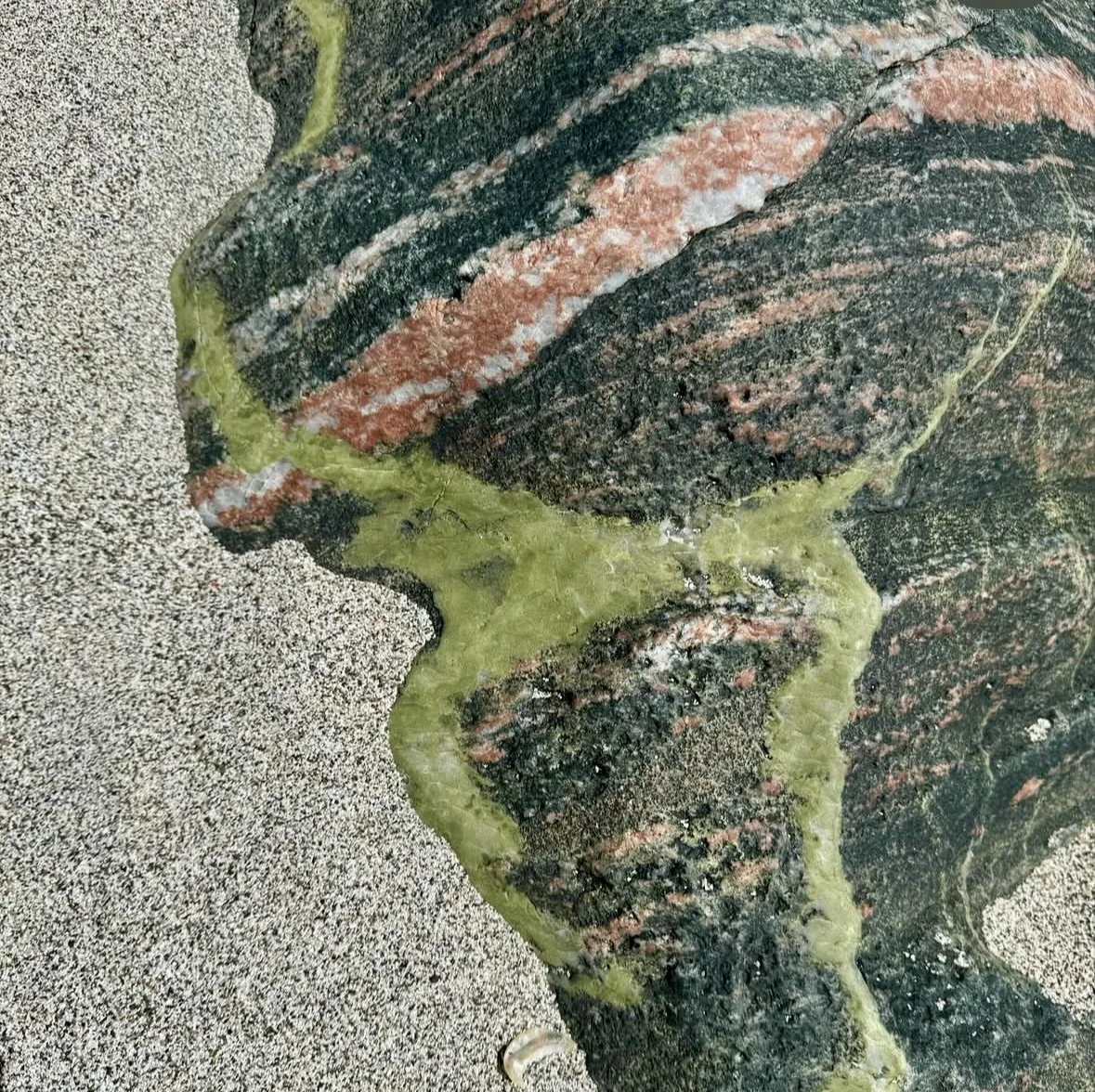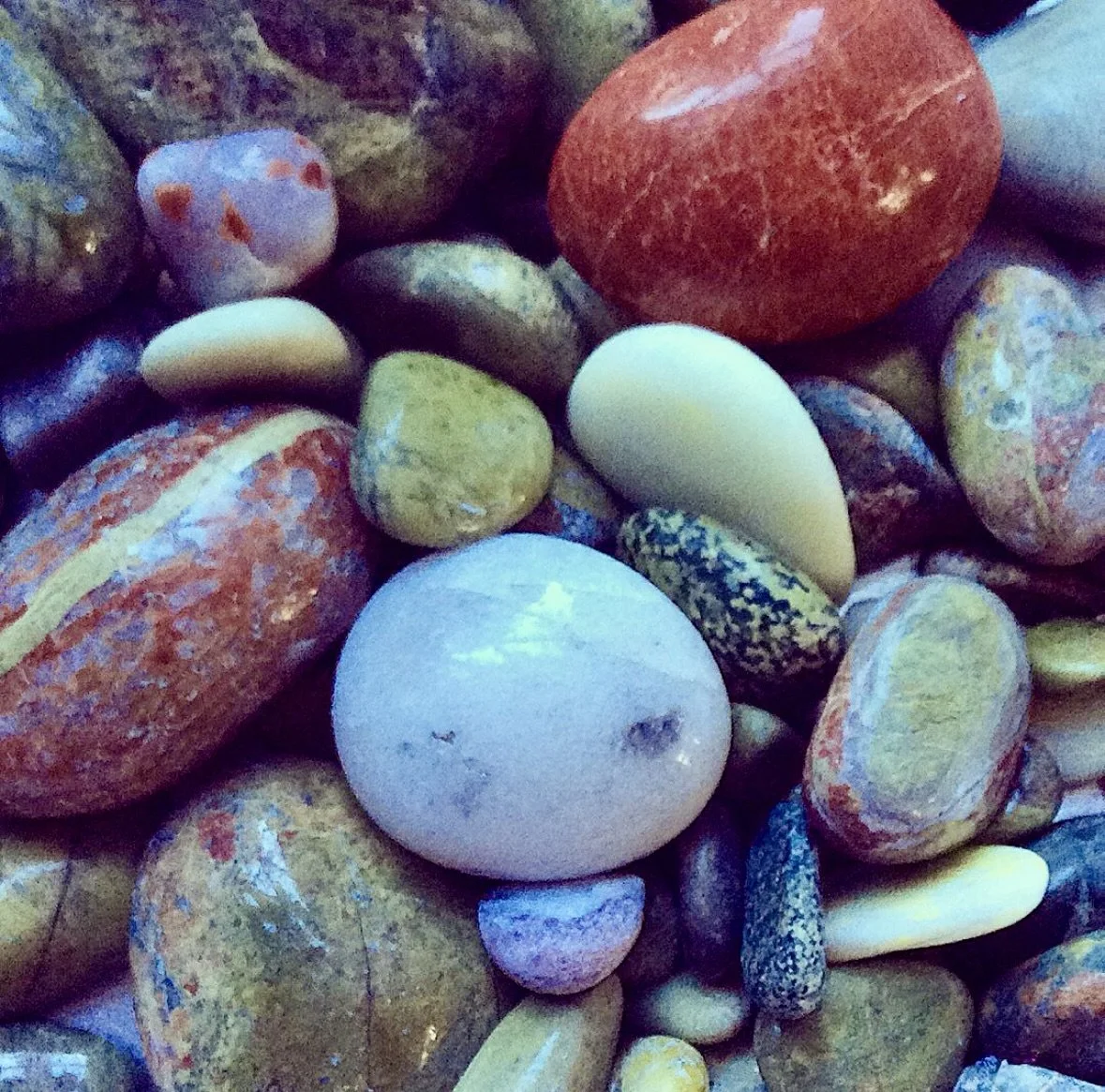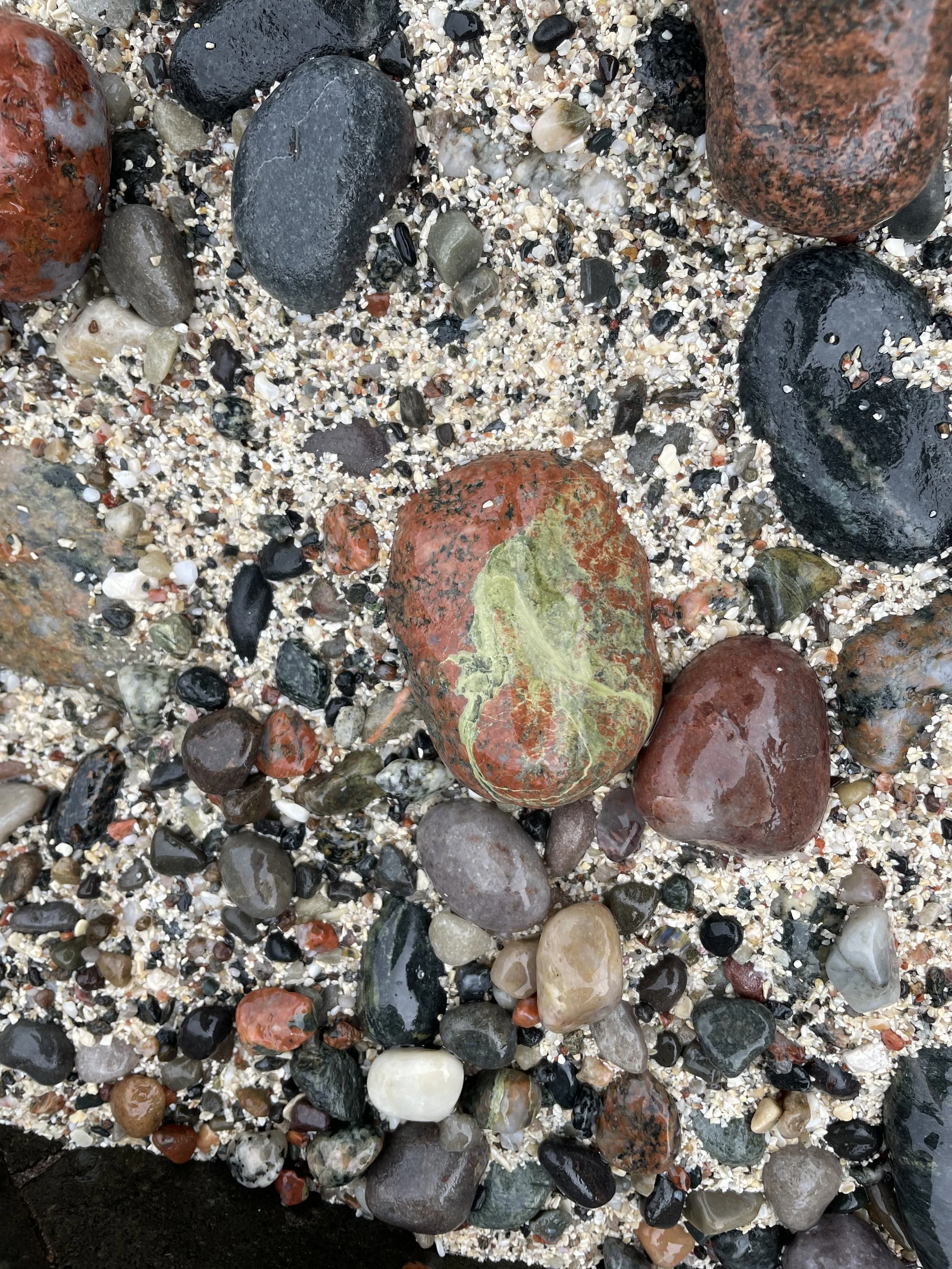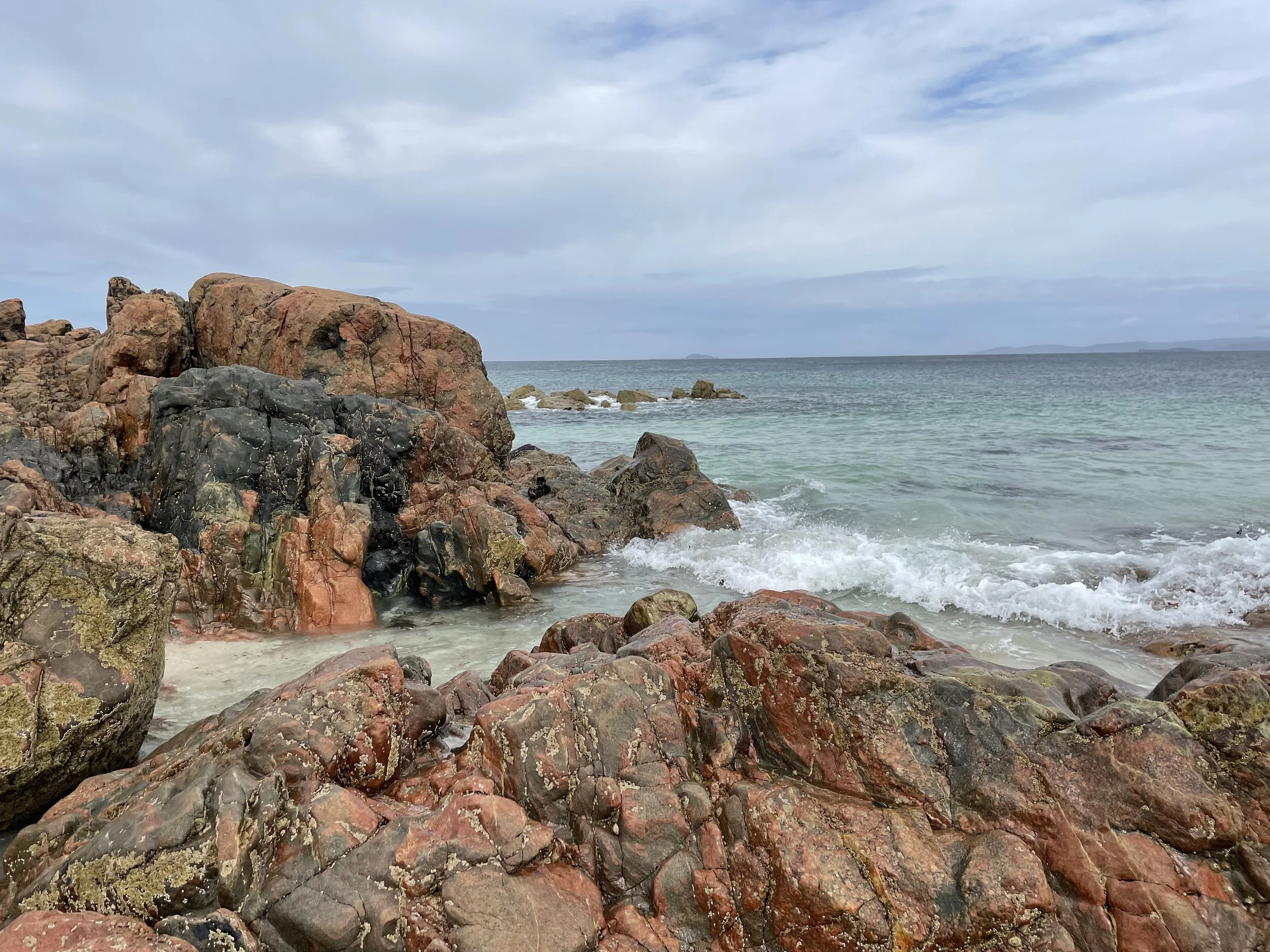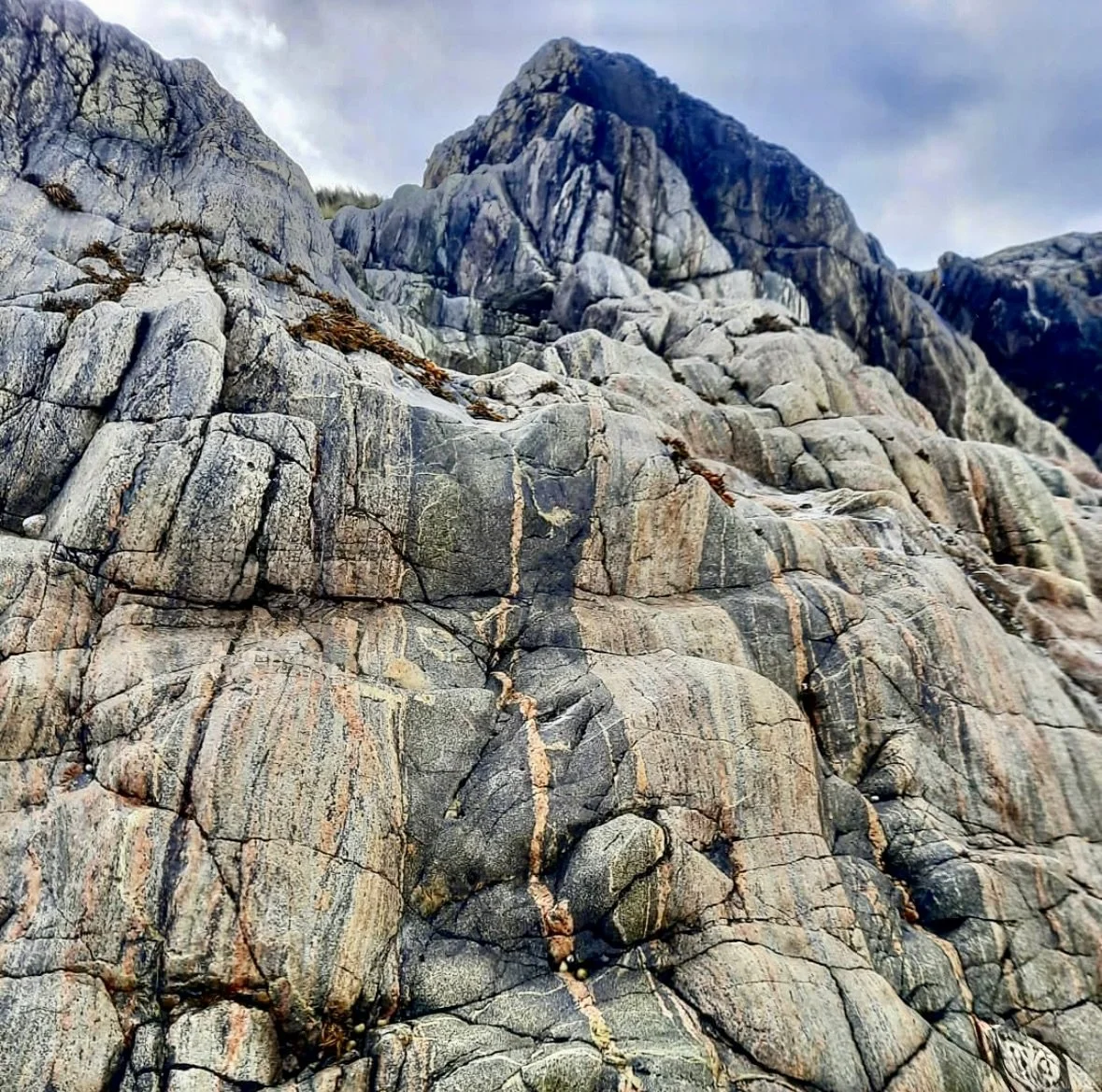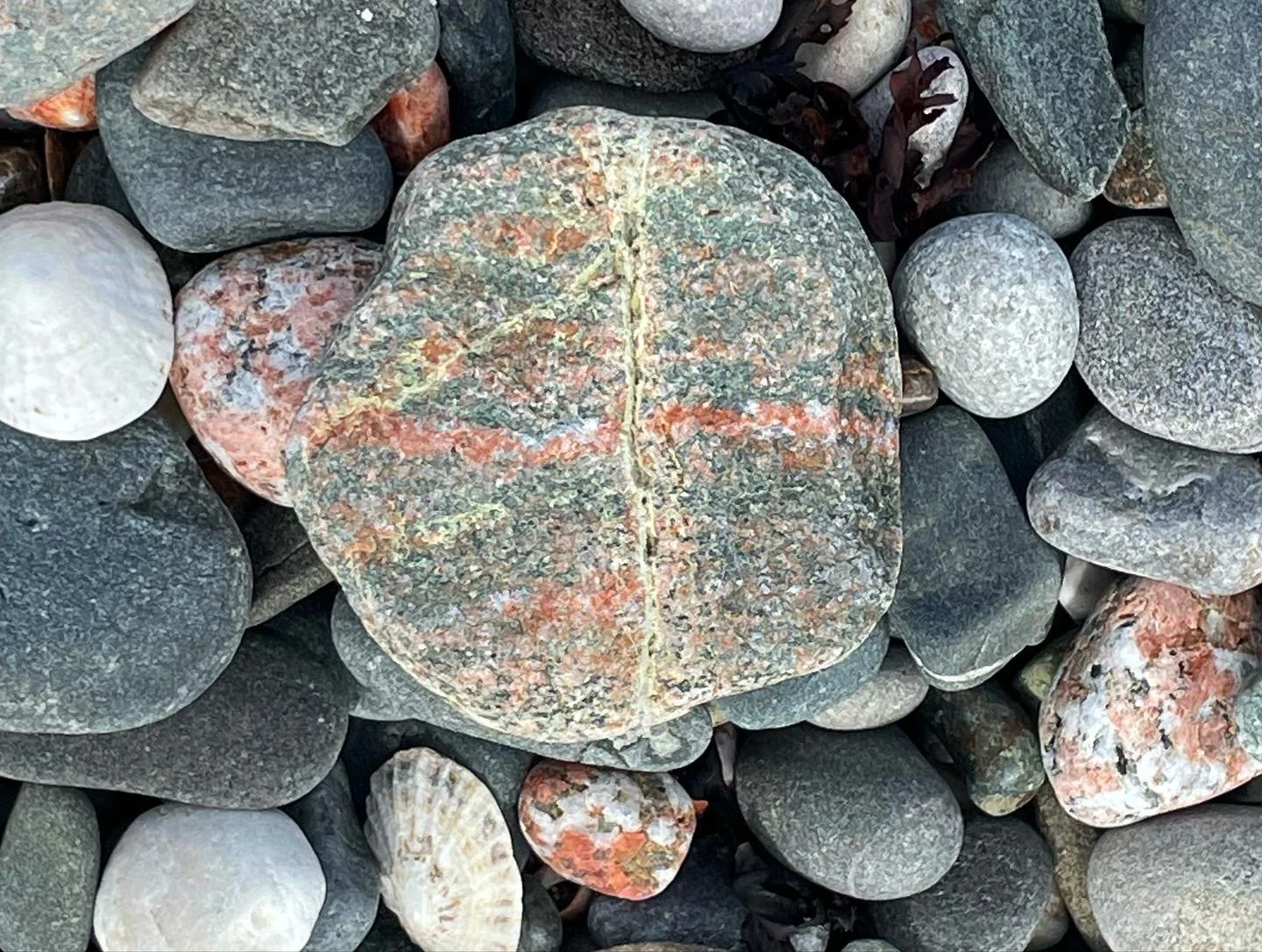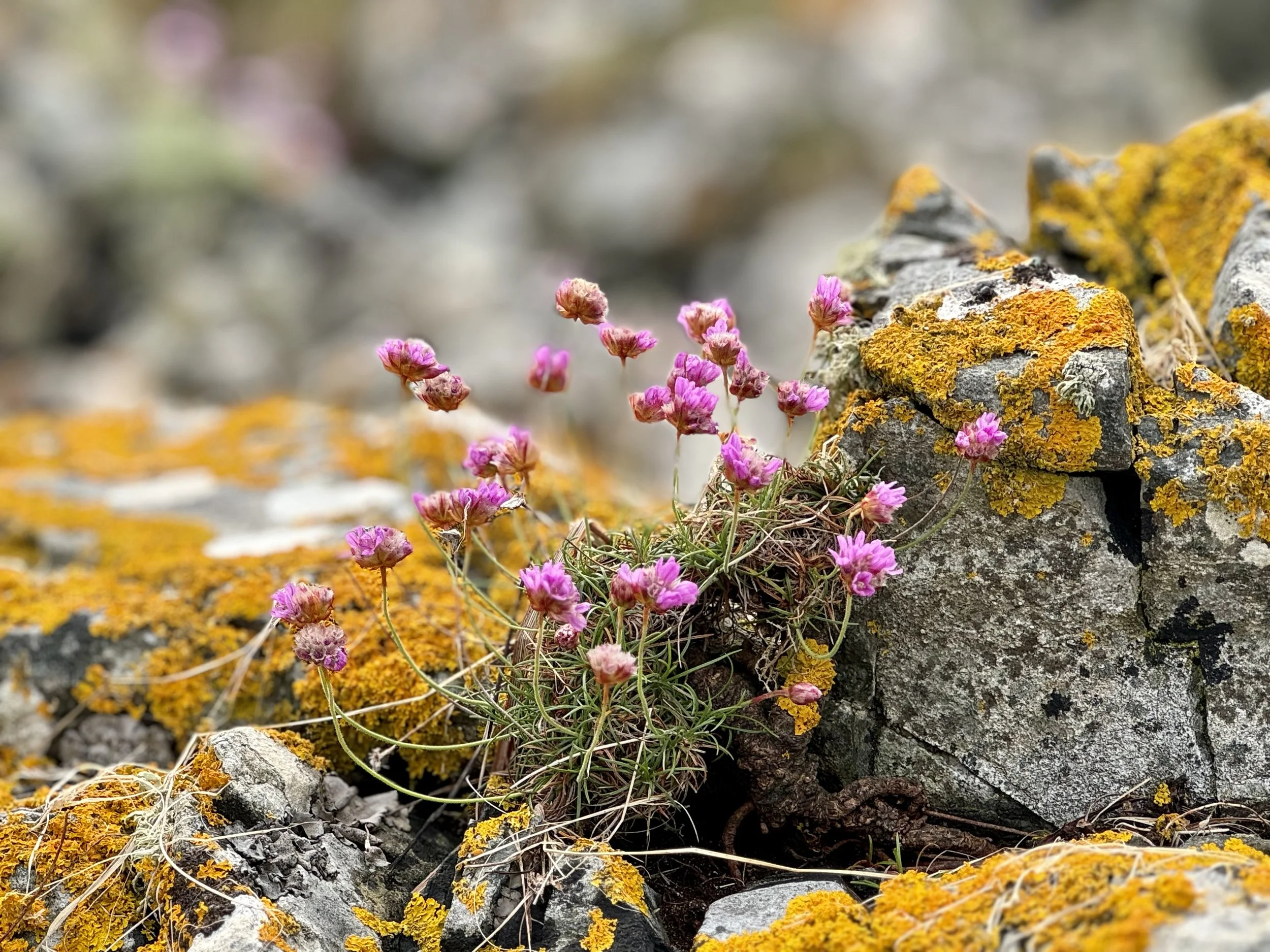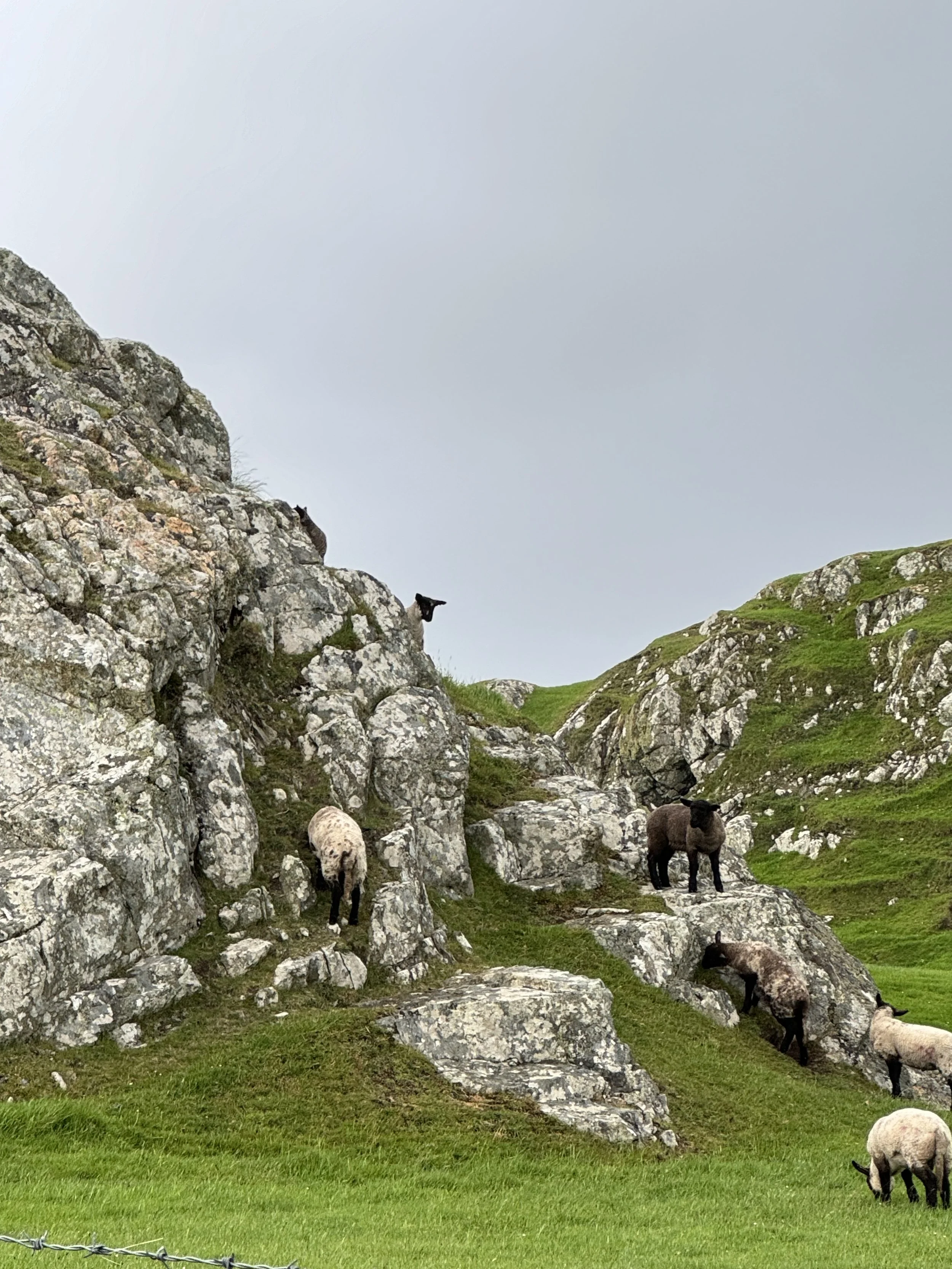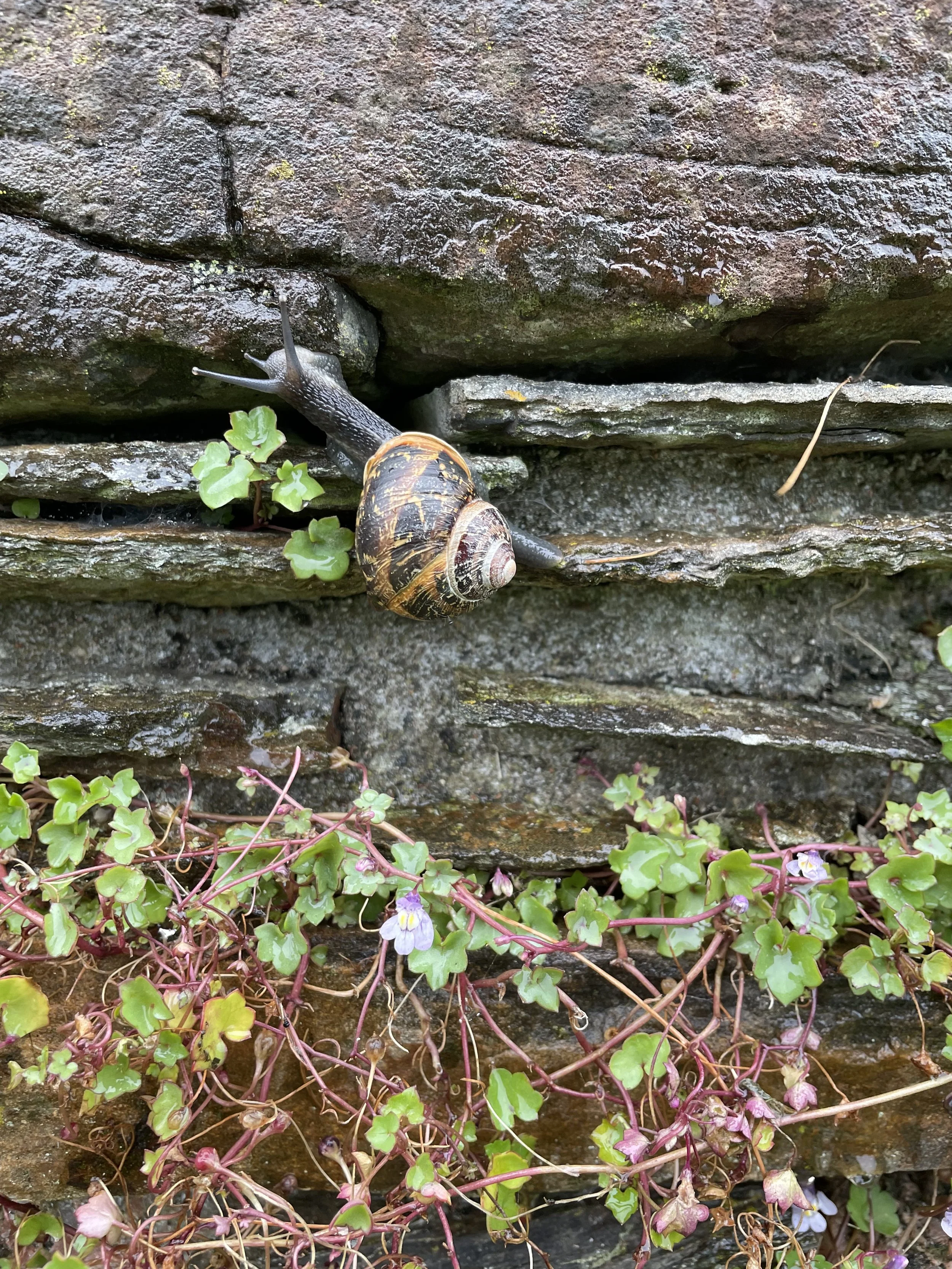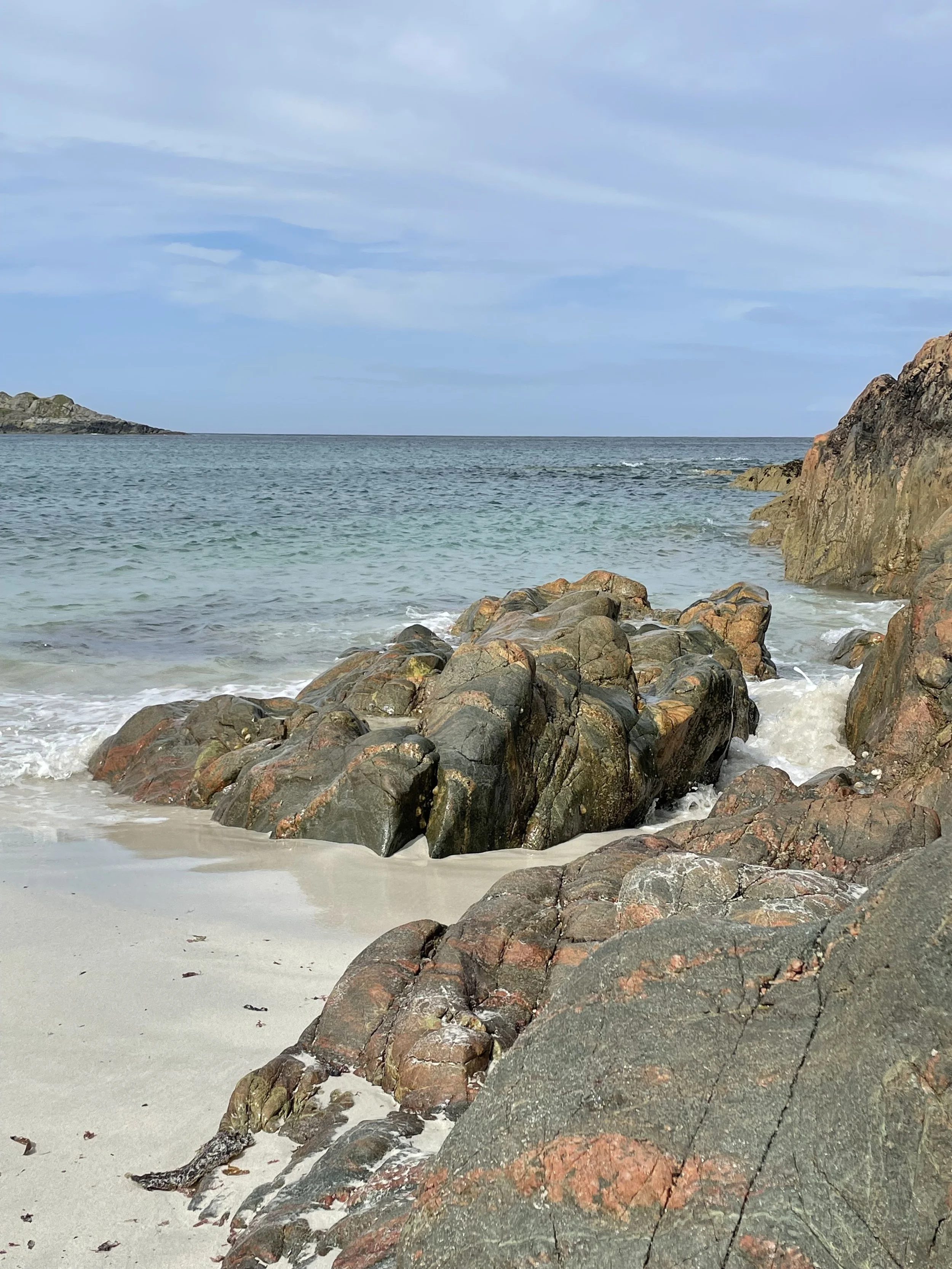Earth
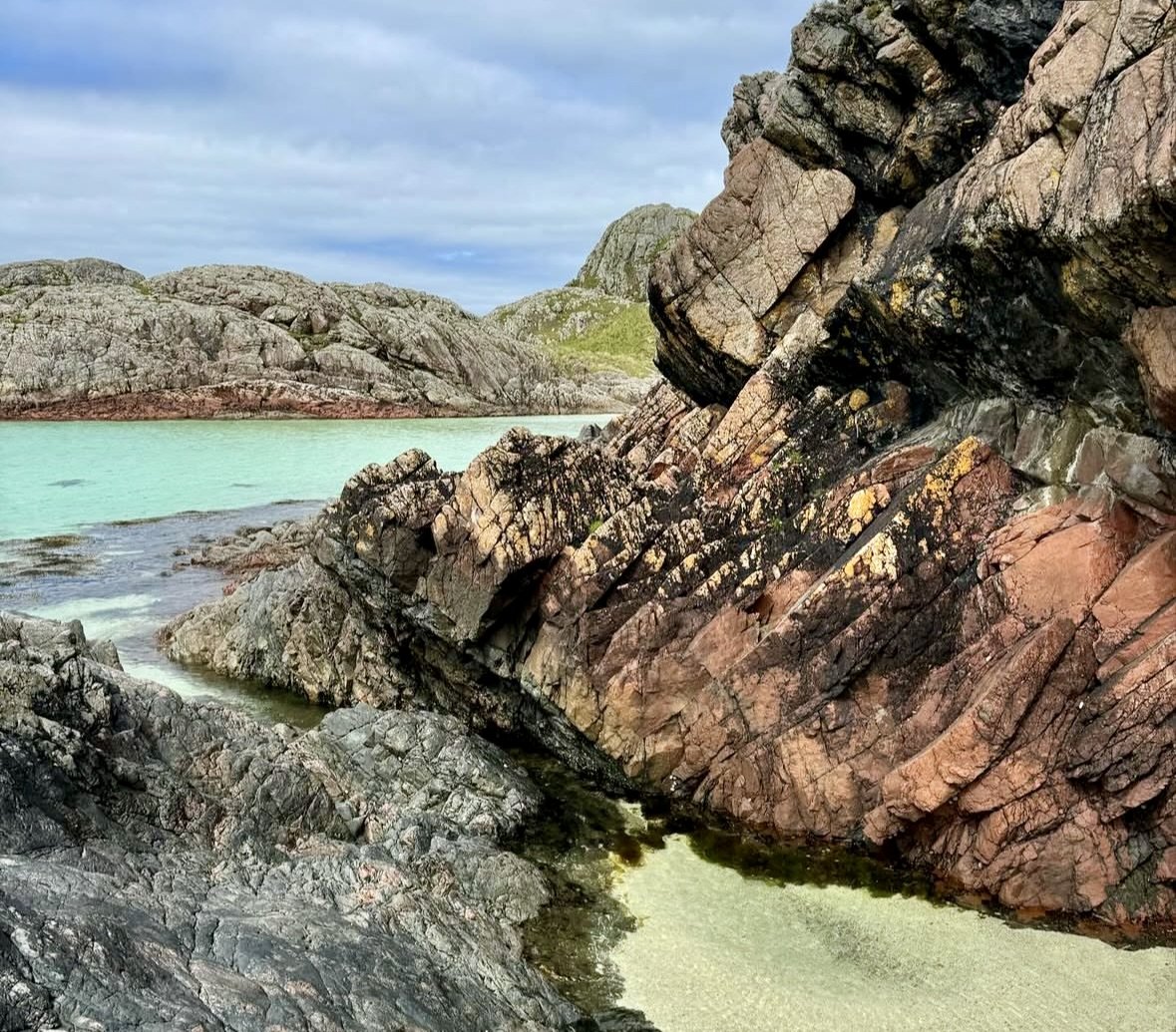
Matter is spirit moving slowly enough to be seen.
There is a stone—a rectangular one, too large to wrap my hand around, green as grass with veins of red, black, pink, and white—resting now at the bottom of the bay off Iona’s southern shore. It was my companion for six years, a touchstone for hope, a witness to the slow transformation of my life.
It’s been three years since the stone found its resting place in the bay, but even now, its life and testimony continue; deep calling to deep, I suppose. It’s a new wonder for me to imagine rocks as having life, but as conservationist and mystic John Muir wrote::
Rocks and waters…are words of God and so are men. We all flow from one fountain Soul.
The rock and I met in that flow.
Teilhard de Chardin
To my knowledge, the only picture that exists of “my” rock is the one in my mind. But, here you can see the colors and striping of Lewisian gneiss.
A handful of pebbles from Columba’s Bay, mostly consisting of gneiss and Iona marble.
When I first encountered that stone, I only knew that it was beautiful and weighty, full of color and of such a size that I would not lose it but could still get it home with me, which is the custom for visitors to Iona. One chooses a rock to carry home as a touchstone for prayer, and upon returning to the island, offers it - and all of the prayers it bears along with it – back to the sea.
At the time, I saw it simply as a grounding stone, something that could anchor me in my own prayer and presence. I didn’t yet understand that it was presence.
John O’Donohue writes:
Landscape is not just matter. It is alive. The landscape is the firstborn of creation. It was here long before us, and it will endure long after we have departed. It holds the presence of the divine as deeply as any human person.
The rock was no mere touchstone or anchor. It was - IS - an anam cara, the Celtic word meaning soul friend or one to whom you could reveal the hidden intimacies of your life in ways that cut across all convention and category.
The stone accompanied me through healing from cancer, discerning ministry in a new tradition, graduating from seminary and my first years of ordained ministry. I once thought I had carried it, but now I know it was holding space for me. It never asked me to articulate my complicated feelings. It did not demand clarity or completion. It simply stayed with me.
I’m grateful that the rock rests again in its own land, returned to its own place. But, as any true anam cara, it is still with me, its story calling to my own, and I find myself more curious than ever about its life before me, the long pilgrimage it made through fire and time before we met.
A splatter-painted masterpiece of Lewisian gneiss on the west beaches. Photo credit: Jennifer Deaton
As part of the bedrock of Iona’s southern shore, it is composed of what geologists call Lewisian gneiss (pronounced nice), which makes it one of the oldest rocks on the planet. It doesn’t just predate dinosaurs, it predates the ability of any life to form fossils. That stone was formed when the world was still the dark void we read about in Genesis 1. The Spirit’s hovering over the waters was apparently so generative that it heated the earth’s core - melting sediment and granites and basalts - forging together what were once distinct.
Scientists tell us the Lewisian gneiss were shaped and reshaped by deep pressure and ancient heat before they cooled in the crust and then became the bones of our young Mother Earth over three billion years ago. They were later twisted and folded, crushed and transformed through six great tectonic movements of the Earth that saw them break through darkness and depth to spill and spread freely in the light of day, each leaving new lines and textures, like wrinkles in a wise old face.
Within the stone, lie fragments of ancient seas — layers of marble, iron, ash, and lava — silent stories of once-living worlds pressed into stone. Dark dikes slice through the gneiss like frozen lightning, some streaked, some smooth, their edges whispering stories of fire meeting stone, of tension and transformation.
Photo Credit: Jennifer Deaton
* The above information is condensed from “The Lewisian and Torridonian Geology of Iona,” a dissertation by Dr. Fiona Menzies, a geologist and resident of Iona.
Photo Credit: @rhulearthsciences on Instagram
“It has been said that to hold a stone of Iona in your hand is to hold the history of the world.”
However, I believe to be near such a stone is to sense history not as past, but as presence.
I can’t know what the rock might say about its journey, but as I wonder over its story, I can only imagine it might cry out in testimony of God’s faithfulness throughout its journey of burning and bending, telling of a grace that flows through all things, in all times and places, grounding all-that-is in holy-ness. It’s life bears witness to the truth that we live and move and have our very being inside the one, incomprehensibly good and gracious fountain Soul that is always creating and re-creating.
Tracy Belzer, A Journey of Sand and Stone
Beauty imbues every nook and cranny of these rocks. Photo credit: Jennifer Deaton
One of my very favorite things about the stones of Iona is the hospitality they show. The stones resting at the shore’s edge don’t resist the winds and waves; they welcome them. In fact, with every ebb and flow the rocks join together as if they are clapping and celebrating the washing and polishing, the wearing and softening of their edges.
And, those loftier rocks that overlook the waters host an astonishing array of life, offering shelter and sustenance to lichen and sea pink, barnacles and moss, and oh so many snails and goats.
And they make space for pilgrims, too: space for wandering and wondering, for rest and reflection, for shelter and surprise. It’s funny how something so solid, so cold and craggy, nurtures such vitality. Somehow, these ancient stones awaken our inner mountain goats, transforming even the most reserved among us into sure-footed scramblers, climbing with wild delight, bleating and laughing our way to the top of every hill.
Perhaps that’s what it means to truly have an anam cara, to be so deeply accompanied that we begin to hear the world differently and to unburden ourselves from what weighs us down.
The stone taught me to listen, not only to God, but to the earth, to my own life, to the quiet truths that do not demand attention but offer it freely. It invited me to embrace my own scars not as ugly wounds but as powerful testimonies of survival and strength.
Photo credit: Jim Melnyk
I no longer carry that stone in my hand, but it continues to hold my attention, its memory alive in my spirit, its stillness a steadying presence in my prayer.
It reminds me that transformation rarely happens in haste. More often, it comes in the way of rocks: through pressure and time, through fire and fracture, through presence that does not flinch in the face of suffering, but welcomes each tectonic shift or wave of life with reverential faith and resilience.
And isn’t that the mystery of grace?
That the old ways can make us new.
That the silent can speak.
That a stone on a windswept shore might become a soul friend, and in its company, we might finally live more fully into who we were always meant to be.
Photo credit: Jennifer Deaton
Reflection
Who or what has accompanied you as a soul friend through significant seasons of your life? Was it a person, a place, an object, an animal, or something else?
In what parts of your life have you felt “shaped by pressure and fire”? What beauty or wisdom has emerged from that shaping?
What spiritual or emotional “fossils” do you carry—memories of past life that now shape your landscape?
Engagement
Wherever you are, if you're able, step outside for a short walk. Let your attention rest gently on the natural world around you. Is there something that seems to draw your notice—a stone, a leaf, a flower, or even an animal? Linger with it for a moment. Imagine its life. What quiet wisdom might it be offering you?
For Perspective
In his book Awe, Dacher Keltner writes about encounters with awe leading to an experience of the “small self.” He’s naming our tendency to be right-sized when faced with majesty and grandeur.
To name Iona’s rocks as ancient fails to capture the wonder of their witness to history. The chart to your right offers perspective on geological time.
You’ll notice that Lewisian gneiss formed somewhere around 3 billion years ago, but pay careful attention also to the tiny, pale sliver on the far left of the spiral. It holds the entirety of human history - not recorded history - but the existence of hominids, which began with primates.
Author John McPhee writes that if our arms were stretched wide to represent the span of time from the beginning of earth to now that, “in a single stroke with a medium-grained nail file you could eradicate human history.”
Lloyd, J. (2024). Geologic time scale – log-spiral (1.0.0). Zenodo. https://doi.org/10.5281/zenodo.10978148
McPhee, John. Annals of the Former World. New York: Farrar, Straus and Giroux, 1998.

